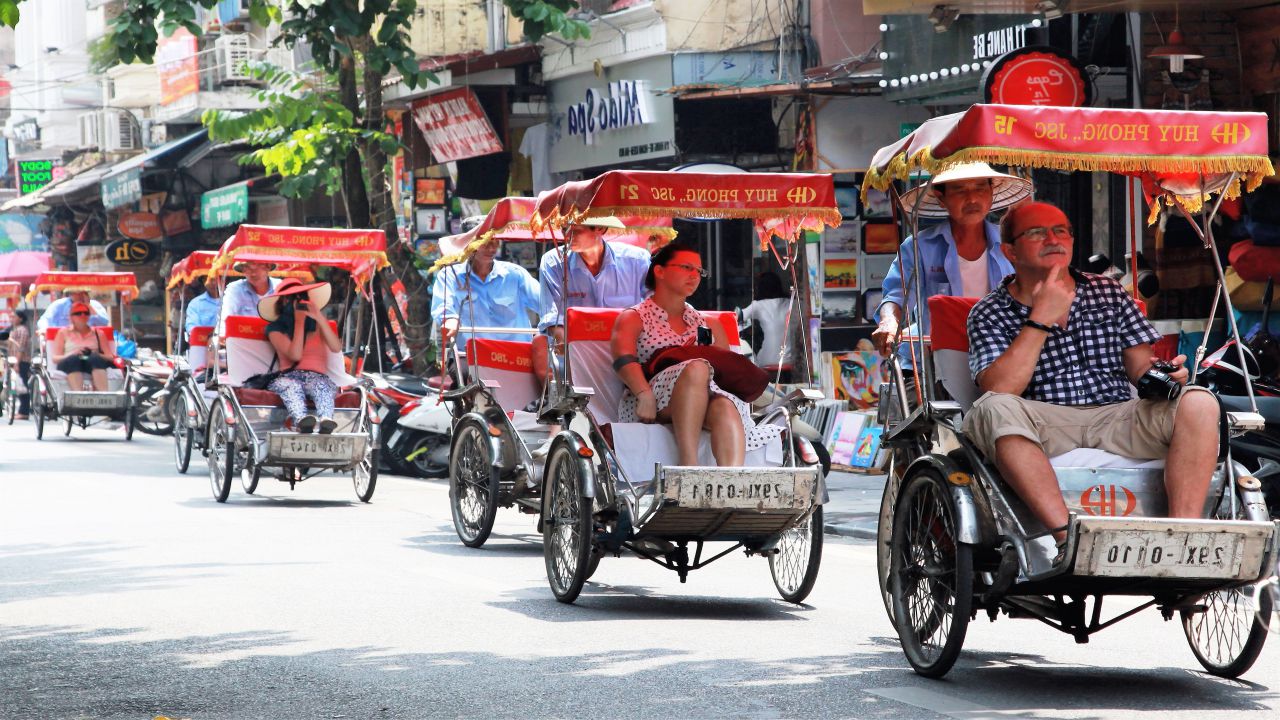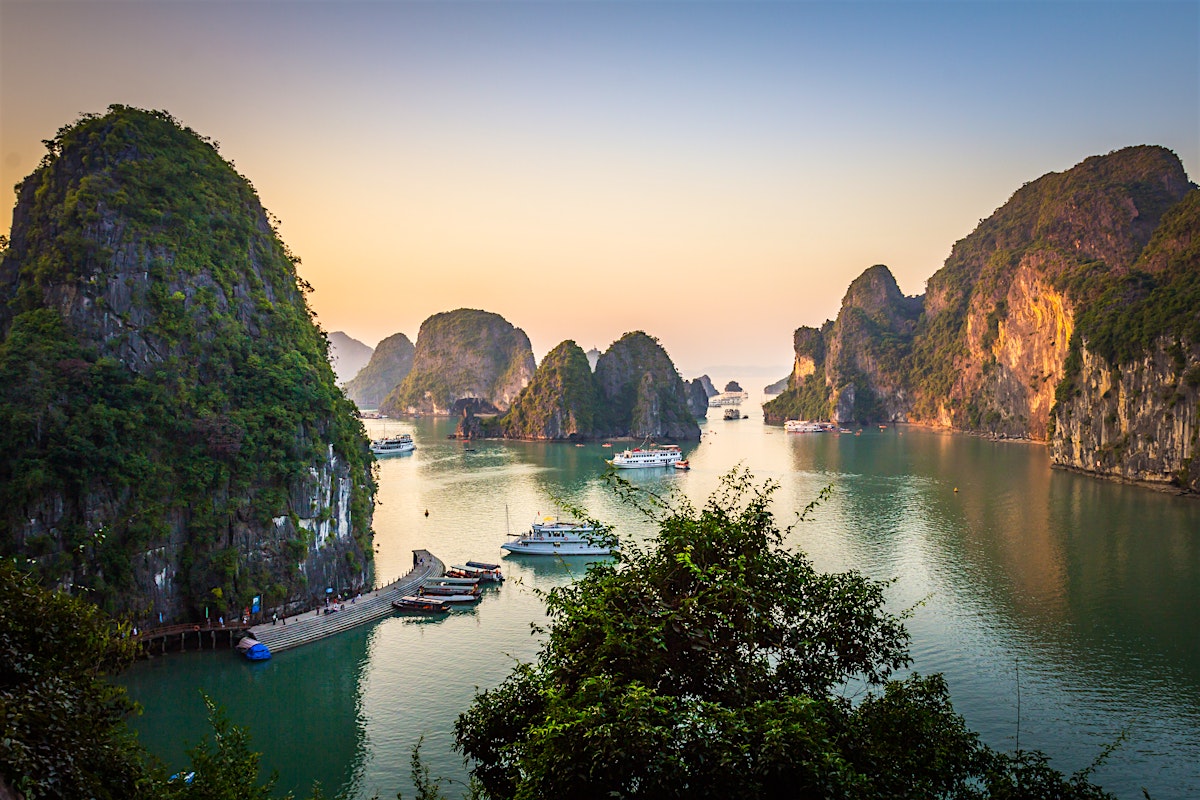DAY 1 : ARRIVE IN HO CHI MINH CITY
Arrive in Ho Chi Minh city …
Customs formalities and luggage recovery (Estimated time approximately 30 minutes).
You will then be greeted by your guide and driver, outside the airport, transfer to the city of Hanoi for a day tour of the city
Ho Chi Minh city : also known as Saigon is the largest city in Vietnam with the population nearly 9 millions. The city is called ‘Diamond of the Far-East’, the same luxury level overriding Hong Kong or Bangkok. Ho Chi Minh city becomes very important city in Vietnam. The nice location at central of the South Vietnam, Ho Chi Minh city becomes very important center of transportation lead to surrounding provinces , bring opportunities to develop the economy and tourism of Eastern and Western area of the South.
Lunch at the restaurant
Visit :
The Central Post Office : is one of the oldest buildings in Ho Chi Minh City. This was built around 1886 – 1891 based on Villedieu’s design, a famous French architect. It has been the busiest post office of the country. Its architecture, with a roof topped by a glass roof, is reminiscent of the buildings of the World Expo. It is a place where it is nice to stop.
The People’s Committee Building of Ho Chi Minh City : was built and put into use in 1909 as a hotel whose original name was Hôtel de Ville. It was designed by Gardes, a famous French architecture. This building is thus one of the oldest, biggest and most beautiful French style buildings in Ho Chi Minh City, functioning both as a city institution and as the city’s most prominent landmark today.
The Saigon Opera House is owning an elegant architecture.The building still many lively evidences for the influence of French architecture in Vietnam. This magnificent building designed by French architect Ferret Eugene, was built as a classical opera house with 800 seats. The style of this majestic building is influenced by flamboyant style of the French Third Republic. Since 1975, he has returned to his original function.
Saigon Notre Dame Cathedral : built in the late 1880s by French colonists, is one of the few remaining strongholds of Catholicism in the largely Buddhist Vietnam. Sitting between two streams of traffic, Notre Dam Cathedral is in the middle of Saigon’s chaotic District 1. A brick, neo-Romanesque church with 40m-high square towers tipped with iron spires. Interior walls are inlaid with devotional tablets and some stained glass survives. In front of the cathedral stands a Virgin Mary statue, which is said to have shed tears in 2005, causing thousands of people to stop around the Basilica.
Ben Thanh Market : is the most famous shopping destination for tourists in Ho Chi Minh City, featuring every type of souvenir the spending traveler desires to buy. The attraction is one of the earliest surviving structures in Saigon and an important landmark of the city. The market was first created as an informal gathering of street vendors near Saigon River.

Dinner at the restaurant
Overnight at hotel in Ho Chi Minh City.
DAY 2 : HO CHI MINH CITY – MY THO – BEN TRE – HO CHI MINH CITY
Breakfast at the hotel
In the morning, take the road south towards My Tho.
Mekong delta : is located in Southwestern Vietnam. The water that moves to the rhythms of the mighty Mekong, where boats, houses and markets float upon the innumerable rivers, canals and streams that criss-cross the landscape like arteries. The bustling commerce of its towns contrasts sharply with the languid, almost-soporific pace of life in the countryside. Here buffalo wallow in rice paddies, coconut- and fruit-laden boats float slowly along the mud-brown waters, and two-wheeled exploration of the narrow lanes is amply rewarded with a true taste of rural hospitality.

Return to Sai Gon.
Dinner at the restaurant
Overnight at the hotel in Saigon.
DAY 3 : HO CHI MINH CITY – HA NOI
Breakfast at the hotel
Then transfer to Da Nang airport for flight to Ha Noi
Takeoff at 10:35 on the flight …
Lunch at the restaurant.
Arrival at Ha Noi at 12:40.

Visite :
Hoan Kiem Lake (Lake of the Restored Sword) : refers to a legend of the great Vietnamese hero, Le Loi, who led a successful uprising against the Chinese in the fifteenth century. Tradition has it that Le Loi netted a gleaming sword while out fishing in a sampan and when he returned as King Ly Thai To, after ten years of battle, he wanted to thank the spirit of the lake. As he prepared the sacrifice there was a timely peal of thunder and the miraculous sword flew out of its scabbard, into the mouth of a golden turtle (Vietnamese use the same word for turtle and tortoise) sent by the gods to reclaim the weapon.
Hanoi Cyclo : an hour cycling around and take photos in the Old Quarter.
The Old Quarter (36 old streets) : has a history that spans 2,000 years and represents the eternal soul of the city. Ha Noi Old Quarter with its old-styled narrow streets full of antique brick houses seems to nostalgically resist the flow of time while still actively trying to adapt to the dynamic atmosphere of the modern city. Once a bustling area where merchants and artisans gathered to sell their products, Ha Noi Old Quarter consists of many small, meandering streets, each bears the name of the goods that was specifically traded there such as Hang Bac (Silver Product), Hang Ma (Paper Product), Hang Go (Wood Product), just to name a few.
Temple of Literature : founded in 1070 by Emperor Ly Thanh Tong, the Temple of Literature is dedicated to Confucius (Khong Tu). Inside you’ll find a pond known as the ‘Well of Heavenly Clarity’, a low-slung pagoda and statues of Confucius and his disciples. A rare example of well-preserved traditional Vietnamese architecture, the complex honours Vietnam’s finest scholars and men of literary accomplishment. It is the site of Vietnam’s first university, established here in 1076, when entrance was only granted to those of noble birth.
Ngoc Son Temple was built in the 18th century on Jade Island in the centre of the ‘Lake of the Returned Sword’ or Hoan Kiem Lake. Legend describes how an emperor was once given a magical sword which helped him defeat the Chinese Ming Dynasty and in doing so saw the return of the Golden Turtle God to the lake.
Dong Xuan market : is the oldest and largest market in Hanoi. Established in 1889, Dong Xuan Market is housed within a four-storey Soviet-style building on the northern edge of Hanoi Old Quarter. It’s also known as Hanoi’s largest indoor market, offering a wide range of goods such as fresh produce, souvenirs, accessories and clothing, as well as electronic and household appliances.
Water Puppet show : is a tradition that dates back as far as the 11th century when it originated in the villages of the Red River Delta area of northern Vietnam. The puppets are made out of wood and then lacquered. The shows are performed in a waist-deep pool. A large bamboo rod supports the puppet under the water and is used by the puppeteers, who are normally hidden behind a screen, to control them. Thus the puppets appear to be moving over the water.
DAY 4 : HA NOI – NINH BINH
Breakfast at the hotel
Departure for Ninh Binh.
Visite :
King Dinh Tien Hoang’s Temple: The temple is located in Truong Yen village, Hoa Lu town, in a garden of 5 hectares wide. It faces the East, and stands in front of Ma Yen Mount, where King Dinh Tien Hoang’s tomb was located.The temple was built in the 17th century, with a special architecture.
King Le Dai Hanh Temple: is almost the same as Dinh Temple in term of architectural design, except for some details. Le Dai Hang temple also consists of three parts: Bai Duong used for the community, Thien Huong, in memory of the royal mandarins of King Le, and finally, the altar in memory of the King.
Trang An Eco-Tourism Complex : is a complex beauty – landscapes called as an ‘outdoor geological museum’ with numerous caves, mountains, valley water, trees and the historic relic. The Trang An eco-tourism site is considered the “Ha Long Bay land”. Here, space was so quiet that the only sounds were those of the trains. In the distance, visitors have the opportunity to perceive the white flowers of the reeds in the foothills. While enjoying fresh air and mountain scenery, which takes visitors into a magical world. On June 25th, 2014, at the 38th session of the World Heritage Committee in Qatar, the UNESCO named Trang An Landscapes Complex as a world heritage, becoming the first recognized cultural and natural heritage site in Vietnam and Southeast Asia.

Lunch at the restaurant.
Dinner at the restaurant.
Overnight at the hotel in Ninh Binh.
DAY 5 : NINH BINH – HA LONG
Breakfast at the hotel
Depart by road from the famous Halong Bay, for a memorable cruise on the bay.
Ha Long Bay : in the Gulf of Tonkin, includes some 1,600 islands and islets, forming a spectacular seascape of limestone pillars. It was called ‘the wonder standing in the heaven’. In the heart of stone islands, there have the beautiful caves such as Thien Cung Cave, Dau Go Cave, Sung Sot Cave, and Tam Cung Cave that are really the castles of the heaven. With the special values, on December 17th 1994, in the 18th session of World Heritage Committee of UNESCO, Halong Bay was officially recognized as the World natural heritage. In November 2000, Halong Bay was recognized by UNESCO as the World natural heritage about the values of geomorphology. On April 27th, officially stated that Halong Bay became one of the Seven Wonders of the World.
Halong Bay Cruise: On board a junk, you’ll have a memorable cruise. Spend your day admiring one of the natural wonders of Vietnam. Visit islets, caves, If the heart tells you, you can make a dip in the jade waters of the Gulf of Tonkin.
DAY 6 : HA LONG – HA NOI
Breakfast at the hotel
You will have the opportunity to see the sunrise over the bay.
After we continue the cruise to Bai Tho Mountain in the other beautiful bay of Bai Tu Long.
Lunch and return to the pier
Back to Hanoi
On the way back to Hanoi, stop at the DAI VIET CO shop to visit or purchase handicrafts, jewelry, souvenirs…

Dinner at the restaurant.
DAY 7 : HA NOI – RETURN
Breakfast at the hotel
Transfer to the airport at … for the flight to Bangkok.
Take off on the flight … to …
SFC Charity